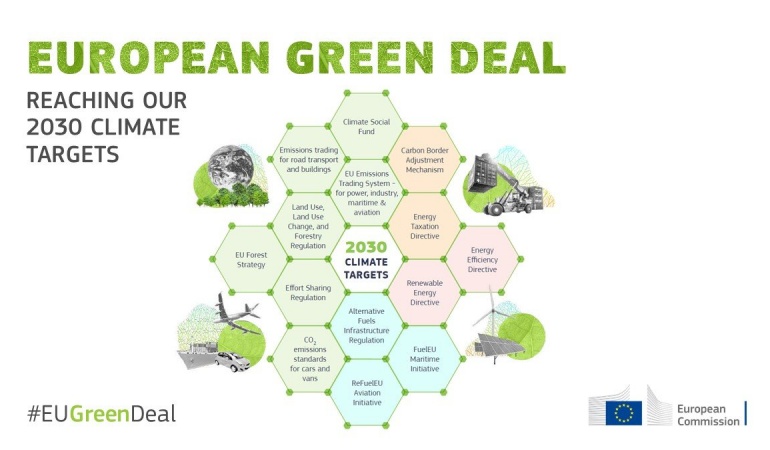News
European Green Deal: Commission adopts new proposals

Yesterday, the European Commission adopted a package of proposals to make the EU's climate, energy, land use, transport and taxation policies fit for reducing net greenhouse gas emissions by at least 55% by 2030, compared to 1990 levels. Achieving these emission reductions in the next decade is crucial to Europe becoming the world's first climate-neutral continent by 2050 and making the European Green Deal a reality.
Overview of the proposals
These proposals are all connected and complementary. We need this balanced package, and the revenues it generates, to ensure a transition that makes Europe fair, green and competitive, sharing responsibility evenly across different sectors and Member States, and providing additional support where appropriate:
- The EU Emissions Trading System (ETS) puts a price on carbon and lowers the cap on emissions from certain economic sectors every year. It has successfully brought down emissions from power generation and energy-intensive industries by 42.8% in the past 16 years. Yesterday, the Commission proposed to lower the overall emission cap even further and increase its annual rate of reduction.
- Member States should spend the entirety of their emissions trading revenues on climate and energy-related projects.
- The Effort Sharing Regulation assigns strengthened emissions reduction targets to each Member State for buildings, road and domestic maritime transport, agriculture, waste and small industries.
- The Regulation on Land Use, Forestry and Agriculture sets an overall EU target for carbon removals by natural sinks, equivalent to 310 million tonnes of CO2 emissions by 2030. The EU Forest Strategy aims to improve the quality, quantity and resilience of EU forests, and plans to plant three billion trees across Europe by 2030.
- The Renewable Energy Directive will set an increased target to produce 40% of our energy from renewable sources by 2030.
- The Energy Efficiency Directive will set a more ambitious binding annual target for reducing energy use at EU level. It will guide how national contributions are established and almost double the annual energy saving obligation for Member States. The public sector will be required to renovate 3% of its buildings each year.
- Average emissions of new cars to come down by 55% from 2030 and 100% from 2035 compared to 2021 levels. To ensure that drivers are able to charge or fuel their vehicles at a reliable network across Europe, the revised Alternative Fuels Infrastructure Regulation will require Member States to expand charging capacity in line with zero-emission car sales.
- The Alternative Fuels Infrastructure Regulation requires that aircraft and ships have access to clean electricity supply in major ports and airports. The ReFuelEU Aviation Initiative will oblige fuel suppliers to blend increasing levels of sustainable aviation fuels in jet fuel taken on-board at EU airports. Similarly, the FuelEU Maritime Initiative will set a maximum limit on the greenhouse gas content of energy used by ships calling at European ports.
- A revision of the Energy Taxation Directive proposes to align the taxation of energy products with EU energy and climate policies, promoting clean technologies and removing outdated exemptions and reduced rates that currently encourage the use of fossil fuels.
- A new Carbon Border Adjustment Mechanism will put a carbon price on imports of a targeted selection of products to ensure that European emission reductions contribute to a global emissions decline, instead of pushing carbon-intensive production outside Europe.
Image © European Commission, 2021






